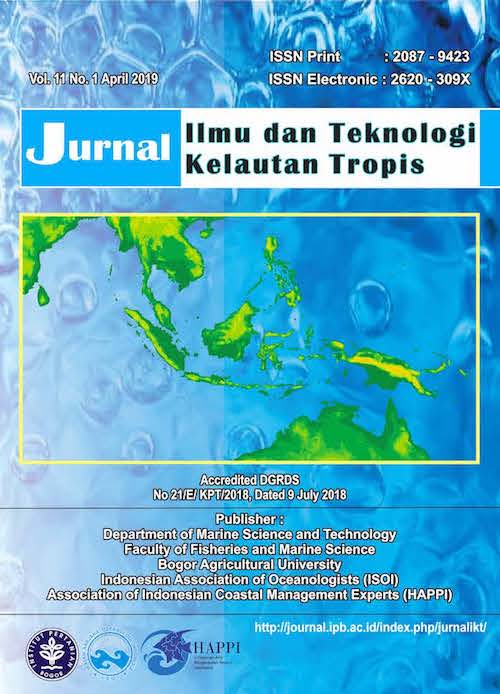ANALISIS KEBERLANJUTAN PERIKANAN ELASMOBRANCH DI TANJUNG LUAR KABUPATEN LOMBOK TIMUR
Abstract
ABSTRAK
Penelitian ini bertujuan untuk menganalisis status keberlanjutan perikanan elasmobranch di Tanjung Luar, Kabupaten Lombok Timur. Analisis menggunakan metode RAPFISH dengan lima dimensi, yaitu dimensi ekologi, ekonomi, sosial, teknologi dan kelembagaan. Hasil penelitian menunjukkan bahwa status keberlanjutan perikanan elasmobranch di Kabupaten Lombok Timur dikategorikan kurang berkelanjutan karena nilai indeks yang dihasilkan hanya sebesar 46,82. Hasil analisis sensitivitas menunjukkan bahwa dari total 37 atribut yang digunakan, teridentifikasi 15 atribut sensitif yang mempengaruhi nilai indeks keberlanjutan perikanan elasmobranch yaitu: komposisi spesies hasil tangkapan, endangered species, threatened species, dan protected species (ETP), kualitas perairan, kepemilikan asset, alternatif pekerjaan dan pendapatan selain menangkap ikan, tingkat pendidikan nelayan, partisipasi keluarga dalam pemanfaatan hasil perikanan, konflik perikanan, kesesuaian fungsi dan ukuran kapal penangkap ikan dengan dokumen legal, selektivitas penangkapan, penangkapan yang bersifat destruktif, tingkat sinergitas kebijakan dan kelembagaan pengelolaan perikanan, rencana pengelolaan perikanan dan kapasitas pemangku kepentingan. Lima atribut yang tersisa dikategorikan tidak sensitif. Penyusunan dan penerapan kebijakan yang konstruktif perlu dilakukan untuk memperbaiki kondisi keberlanjutan perikanan elasmobranch di Kabupaten Lombok Timur.
ABSTRACT
This study aims to analyze the status of sustainability of elasmobranch fisheries in Tanjung Luar, East Lombok Regency. The method used was RAPFISH analysis using 5 dimensions, namely ecology, economics, social, technology and institutions. The results showed that the sustainability status of elasmobranch fisheries in East Lombok Regency was categorized as less sustainable because the index value produced was only 46.82. The results of the sensitivity analysis showed that of the total 37 attributes used, 15 sensitive attributes were identified which affected the index sustainability value of elasmobranch fisheries, namely: composition of catched species, endangered species, threatened species, and protected species (ETP), water quality, asset ownership, alternative employment and income other than fishing, fisherman education level, family participation in fishery product utilization, fisheries conflict, suitability of function and size of fishing vessels with legal documents, catch selectivity, destructive arrests, level of synergy of fisheries management policies and plans, plans fisheries management and stakeholder capacity. While there maining 5 attributes are categorized as insensitive. The development and implementation of constructive policies need to be carried out to improve the condition of the sustainability of elasmobranch fisheries in East Lombok Regency.
Authors
This work is licensed under a Creative Commons Attribution 4.0 International License.
Jurnal Ilmu dan Teknologi Kelautan Tropis i is an open-access journal, meaning that all content is freely available without charge to the user or their institution. Users are allowed to read, download, copy, distribute, print, search, or link to the full texts of the articles in this journal without needing to request prior permission from the publisher or the author.
All articles published by Jurnal Ilmu dan Teknologi Kelautan Tropis are licensed under the Creative Commons Attribution 4.0 International License. This allows for unrestricted use, distribution, and reproduction in any medium, provided proper credit is given to the original authors.
Authors submitting manuscripts should understand and agree that the copyright of published manuscripts is retained by the authors. Copyright encompasses the exclusive rights of authors to reproduce, distribute, and sell any part of the journal articles in all forms and media. Reproduction of any part of this journal, its storage in databases, and its transmission by any form or media is allowed without written permission from Jurnal Ilmu dan Teknologi Kelautan Tropis.


